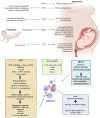Gestational Viral Infections: Role of Host Immune System
- PMID: 37512810
- PMCID: PMC10383666
- DOI: 10.3390/microorganisms11071637
Gestational Viral Infections: Role of Host Immune System
Abstract
Viral infections in pregnancy are major causes of maternal and fetal morbidity and mortality. Infections can develop in the neonate transplacentally, perinatally, or postnatally (from breast milk or other sources) and lead to different clinical manifestations, depending on the viral agent and the gestational age at exposure. Viewing the peculiar tolerogenic status which characterizes pregnancy, viruses could exploit this peculiar immunological status to spread or affect the maternal immune system, adopting several evasion strategies. In fact, both DNA and RNA virus might have a deep impact on both innate and acquired immune systems. For this reason, investigating the interaction with these pathogens and the host's immune system during pregnancy is crucial not only for the development of most effective therapies and diagnosis but mostly for prevention. In this review, we will analyze some of the most important DNA and RNA viruses related to gestational infections.
Keywords: DNA viruses; RNA viruses; immune system; pregnancy; viruses.
Conflict of interest statement
The authors declare no conflict of interest.
Figures




Similar articles
-
Host Defenses to Viruses: Lessons from Inborn Errors of Immunity.Medicina (Kaunas). 2022 Feb 7;58(2):248. doi: 10.3390/medicina58020248. Medicina (Kaunas). 2022. PMID: 35208572 Free PMC article. Review.
-
Host-virus interaction and viral evasion.Cell Biol Int. 2021 Jun;45(6):1124-1147. doi: 10.1002/cbin.11565. Epub 2021 Feb 19. Cell Biol Int. 2021. PMID: 33533523 Free PMC article. Review.
-
Acute Infection of Viral Pathogens and Their Innate Immune Escape.Front Microbiol. 2021 Jun 22;12:672026. doi: 10.3389/fmicb.2021.672026. eCollection 2021. Front Microbiol. 2021. PMID: 34239508 Free PMC article. Review.
-
[How the bovine viral diarrhea virus outwits the immune system].Dtsch Tierarztl Wochenschr. 2006 Apr;113(4):124-9. Dtsch Tierarztl Wochenschr. 2006. PMID: 16716045 Review. German.
-
RNA Sensors as a Mechanism of Innate Immune Evasion among SARSCoV2, HIV and Nipah Viruses.Curr Protein Pept Sci. 2021 Oct 26;22(4):273-289. doi: 10.2174/1389203722666210322142725. Curr Protein Pept Sci. 2021. PMID: 33749559 Review.
Cited by
-
The Complex Role of CD8+ T Cells in Placental HIV Infection.Eur J Immunol. 2025 Jun;55(6):e51615. doi: 10.1002/eji.202451615. Eur J Immunol. 2025. PMID: 40498383 Free PMC article. Review.
-
Dengue infection during pregnancy and the occurrence of pathological neonatal outcome: a systematic review and meta-analysis.F1000Res. 2025 Feb 10;13:1523. doi: 10.12688/f1000research.158890.2. eCollection 2024. F1000Res. 2025. PMID: 40792237 Free PMC article.
-
Safety and Efficacy of Antiviral Drugs and Vaccines in Pregnant Women: Insights from Physiologically Based Pharmacokinetic Modeling and Integration of Viral Infection Dynamics.Vaccines (Basel). 2024 Jul 16;12(7):782. doi: 10.3390/vaccines12070782. Vaccines (Basel). 2024. PMID: 39066420 Free PMC article. Review.
-
Neonates at Risk: Understanding the Impact of High-Risk Pregnancies on Neonatal Health.Medicina (Kaunas). 2025 Jun 11;61(6):1077. doi: 10.3390/medicina61061077. Medicina (Kaunas). 2025. PMID: 40572764 Free PMC article. Review.
-
Oxidative Stress Induced by Antivirals: Implications for Adverse Outcomes During Pregnancy and in Newborns.Antioxidants (Basel). 2024 Dec 12;13(12):1518. doi: 10.3390/antiox13121518. Antioxidants (Basel). 2024. PMID: 39765846 Free PMC article. Review.
References
Publication types
LinkOut - more resources
Full Text Sources

